People have been asking me how they can dive in Malpelo or do a liveaboard charter now that Yemaya, which I considered to be the safest dive vessel at the time, is no longer operating. I couldn’t recommend anyone else.
Last month I had the opportunity to check out the operation of the new liveaboard Ferox. I fell in love with the boat very quickly!
1. Its operation is better than any other liveaboard that has been to Malpelo before.
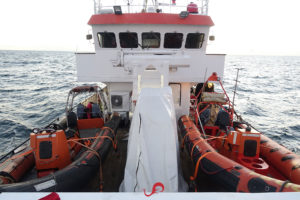
Ferox is not a boat, it’s a ship!
This 11-mm-hull ice breaker is a former Swedish navy boat that used to drop bombs on unidentified submarines entering Swedish waters during the cold war. (It was built in 1995.) The owner sailed the boat from Sweden to Colombia when he bought it.
It is a SOLAS-certified ship, which means that it’s practicing the highest standards of sea safety.
I did my own personal tour around the ship when I was onboard. I found all safety equipment, from firefighting gear to fire suppressants, to be up-to-date and operational. Also, they use Inergen®, which is a mixture of nitrogen, argon and carbon dioxide, instead of the traditional CO2 suppression system that you normally find on dive boats. This combination of chemicals allows the person in the room to continue to have an oxygen supply for as long as possible until the fire is put out.
Each diver is equipped with a whistle, dive light, AIS Man Overboard Device and a surface marker buoy (SMB).
2. It’s manned by a solid and experienced crew.
I approve of the crew, who are mostly locals and ex-marines. For example, Wilson, who serves your food, can easily get you stitched up if you get a cut.
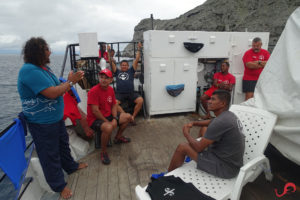
Daily crew meeting to talk about operations and safety
They are not clueless kiddos that I have had to deal with too many times on many liveaboards around the world; nor are they spoiled locals or foreigners (like me) with no experience. And I’m not even going to talk about what I think about “dive professionals.” I know they didn’t come from PADI, SSI or NAUI. They come from the sea.
The owner, Tony, might be new in the recreational diving industry, but he has spent many years captaining commercial diving boats.
Everyday the crew get up at 6 am; then at 6 pm they meet to discuss how the day went and how to improve the operation, making sure to keep a log of the meetings. I was very impressed.
3. There is more than enough room for everyone.
The boat might be missing some creature comforts like a jacuzzi, etc., but it’s a very functional boat for this kind of expedition. The front deck has so much space that I will bring my skipping rope next time. If you’re a tall person like me, you can also skip and jump to your head’s content on the top deck. Then there’s the top, top deck that’s great for whale watching if Gorgona is part of your itinerary.
Best of all, there are only 12 divers onboard!
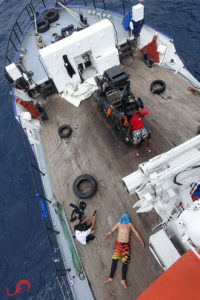
An extremely comfortable front/sun deck
How This Works
I’m going back to Malpelo onboard Ferox not for the money, but because I love the Island and I found a safe boat with a responsible owner.
I am looking for six (6) divers so that I can charter half the boat. I will work as a crew member, but I will give full attention to my 6 divers. I will do my best as a guide and I won’t rest until we are on land. I can help with improving your vegetarian food, but not with your chocolate on your pillow. In that case you are not the diver I want to guide.
I would like to have skilled (at least 200 dives) and patient divers, preferably divers whom I have guided before. Photographers and friends of previous guests are also welcome.
I know my work as a guide very well. However, this is my first time to set up a group, so this is new to me. What I would like to achieve is that we have a team of divers where I don’t need to be a shepherd so that I can focus on my work and do my best to find creatures underwater.
I am not charging anything extra for this. You pay the rack rate for the trip and you pay directly to Colombia Dive Adventures. I take my commission, which covers my costs for getting a good group and doing the best I can when we get there. It takes work to inspect and organize a trip.
Where To Go
We will meet up at Hotel Intercontinental in Cali (Colombia). There are cheaper hotels close by if you want other options.
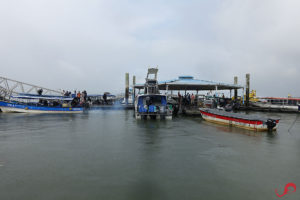
The port of Buenaventura
Jaime and I will be your dive guides and one of us will meet you in the lobby. We will go on a 3- to 4-hour scenic bus ride to Puerto Buenaventura, making one stop in a place with a beautiful view and where you can get something to eat or go for a bathroom break.
Getting in to the port of Buenaventura, you will not receive a Hilton or a One-and-Only kind of welcome. We will all disembark and we will all keep an eye on our bags. The crew are completely trustworthy, but for some of you this might be the only time that you will experience the reality of Colombia.
I declare it’s safe.
The dive skiffs will take us and our luggage to the mother ship, which is anchored in the Bay of Buenaventura. You might want to bring a light jacket for the occasional rain if you don’t want to get wet.
What To Expect
The Service
Onboard you will be greeted by Tony and the crew. While you may not receive 5-star service, the men do their best; and they get “bester” each time. They do their best with vegetarians and fruits are plentiful on the boat. Sometimes you do need to ask for spices and something extra; if they have it, then you will get it. I am a Swede living in Mexico and brought my own chili sauce… I’m picky!
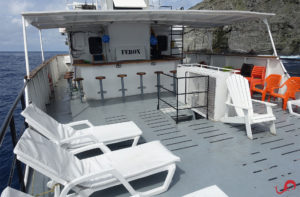
Skip rope area for tall people
Food is served on the dive deck, or on the top deck by the bar as the dive deck can be a bit noisy when the compressor is filing tanks.
The Cabins
The cabins are functional and have enough space for a big person like me. (I’m 1.96 m and 100 kg.) Maybe you won’t find a beautiful picture frame on your wall or a chocolate on your pillow when you go to bed, but you’ll have a decent bed and a good shower. (Personally I prefer to shower on the back deck.)
Electricity is 220 V and you can get an adapter. Or even better, bring your own.
The Diving
There are two RHIBs with twin 2-stroke outboard engines. 2-stroke engines are practical because that is what you can fix out there; you are not in Florida. One is a Delta and the other is an Avon. They may not be pretty to look at, but those are the kind of boats that I want to have. They are uncomplicated and reliable, which are what you need in places like Malpelo.
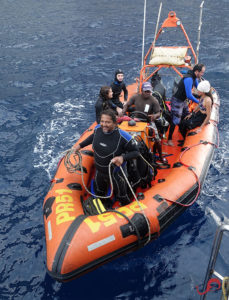
One of two dive skiffs with twin 75-hp outboard engines
I’m sorry there’s no sunshade… Your gear stays in the skiff for the entire duration of your stay in Malpelo.
I do the general dive briefing for all divers before we arrive to Malpelo. Jaime and I constantly exchange information in order to maximize your dive experience. Onboard we all work as a team.
We normally go to different sites—2 groups of 6 divers each with one guide per group. Guiding Malpelo is really a skill, so having an excellent guide with a lot of experience in this area is very important. I worked with Jaime on Yemaya before; he’s the one I trust. We are only a handful of guides who know Malpelo very well.
We do negative entries on all the dives. If you have a big SLR camera, get over quickly to the boat so that the guide or captain can give you “your precious.” I used to say that we care more about your camera than you… but we don’t take any responsibility for it.
I normally go straight down and point where to go. If we wait too much, we will miss the dive site since Malpelo often has strong currents.
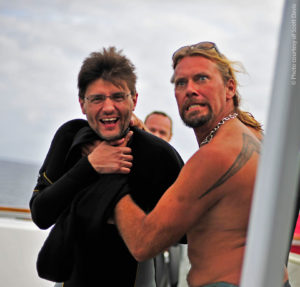
Not only will your diving get canceled, you will also experience the Viking chokehold if you endanger your life.
You dive with the guide. The guide goes slowly, so it should not be a problem for you to keep track of him. If the current is stronger, be more alert and keep your eye on the group.
If you get lost and neither the guide nor your group is in sight, follow your smallest bubbles up to the surface, skip the safety stop and inflate your sausage. The skiff driver will pick you up.
If you don’t do so and follow a whale shark 2 miles away from your group, you endanger not only your life but mine! (It has happened before.) And you will have to deal with a not-so-pleased Viking, who will cancel the rest of your diving. I will not risk my life or other divers’ lives and ruin their vacation because of one irresponsible diver.
The dive sites are set per dive. I personally don’t like to plan too much because mother nature has her own mind. Sometimes I take a peek into the site before we go in, other times I tell you to get dressed and we will decide what to do when we get to the site. The conditions in Malpelo change all the time.
When To Go
I wish I could tell you! Every time I go to Malpelo it’s like starting over again, which puts a lot of pressure on us guides.
Diving is year-round. Winter, as in the western hemisphere, is from November to March. Come summer the wind and the waves change direction.
In general, there are more hammerheads in shallower water during wintertime, but there is less visibility. When I was there in July we didn’t see as many hammerheads even if we had 30-meter viz.
The silkies that school in the thousands? Based on the 35-40 trips I have done, I can’t give a definitive answer.
The whale sharks are normally present from late summer to autumn.
My charter is from 18th to 28th of April 2019. I hope you can join me.
If you want to be part of my first liveaboard charter or if you have any questions, contact my wife because I’m out at sea. She keeps an eye on my emails (sten@jamtsisu.com) when I’m away.


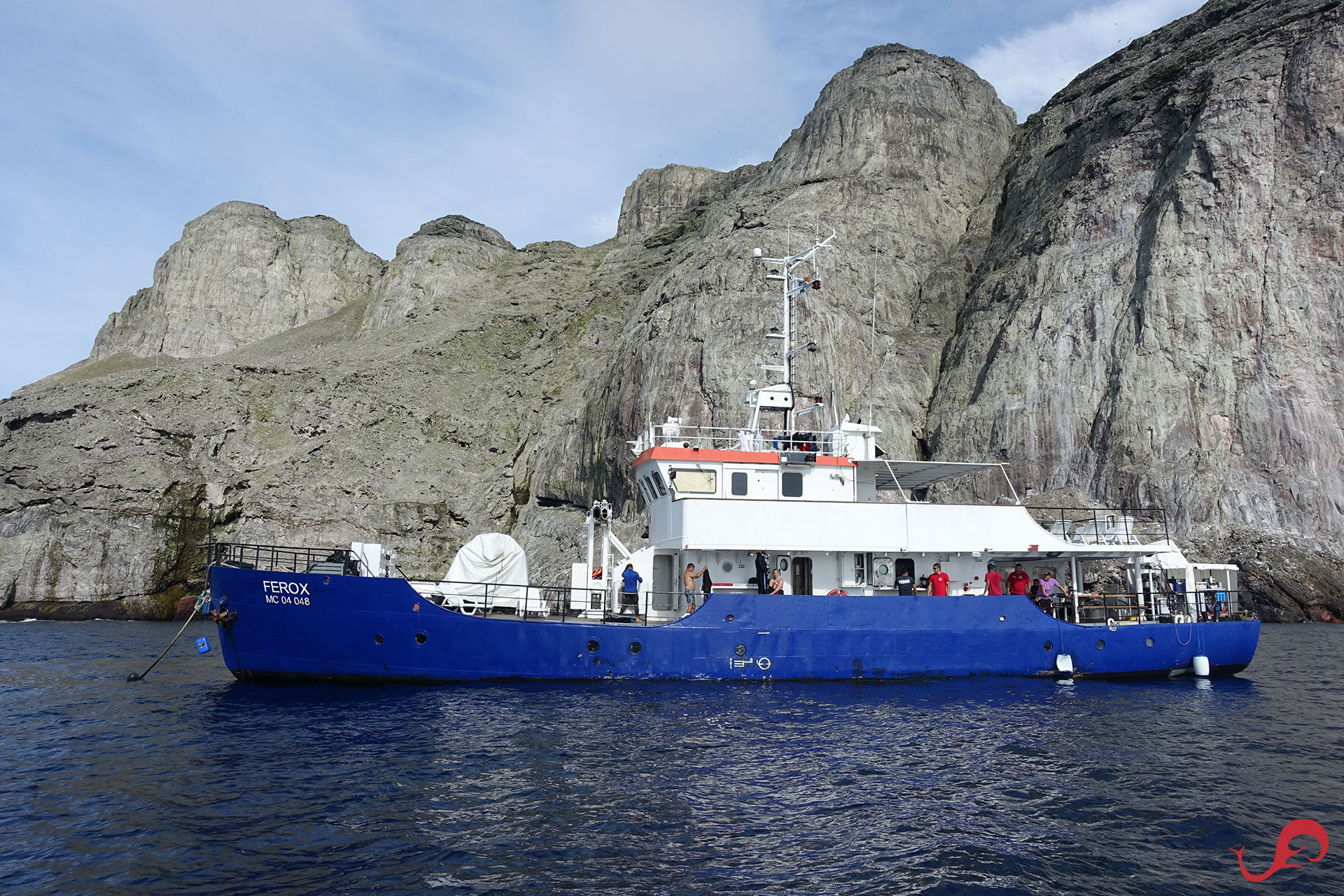
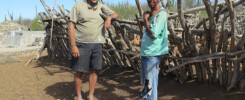
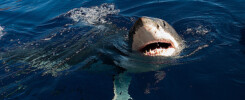
I am already on an expedition during those dates however I would be in for the next one for sure. Please keep me in mind thanks. How much is it by the way?
Hi Sean!
Sorry for the late reply! I have been out at sea.
I have confirmed two more dates for half charter, which means 6 divers and me as a guide for 2020. It will be on June 19th to 29th and July 6th to 15th. It is in the time of the year I consider the better time to be in Malpelo. I had the privilege to be first to reserve these dates. Let me know if either of these dates suits you.
I have one spot left on the April 18th to 28th, 2019 trip, in case you know anyone who would be interested.
I (which really means my wife) will send you a price list for 2020. She is much more organized than I am. 😉
Best regards,
Sten
Sten, I’m glad I found your post! Am in Costa Rica after our 5th trip to Cocos Island – the place that is second best next to Malpelo! We (Venessa and myself) got to dive Malpelo once with you and twice with Jaime so it sounds like we want to participate In one of your 2020 charters! As you know we think you are the best dive master in the world! I have one question. Is traveling in Columbia itself safe for Americans?
Hi Joe!
So nice to hear from you!
I would say Colombia is safe for Americans, as safe for Europeans and other nationalities. We meet up in a hotel in Cali. I do recommend to have a look around the town to see a bit of Colombia.
You get picked up in the hotel. It’s about 4 hours by bus, a very scenic trip. We stop halfway for lunch. Buenaventura has a bad reputation, but things in Colombia have calmed down and getting there we just go to the pier and then take the skiffs out with our luggage to Ferox that is anchored in the bay. I don’t feel any worries coming to Colombia, just like Panama when I worked on Yemaya before.
I hope we can meet up again at the rock!
Sten